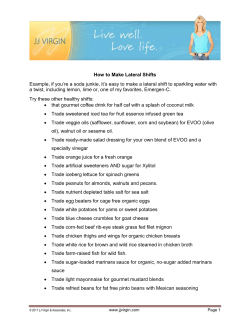
2143606 - Gujarat Technological University
GUJARAT TECHNOLOGICAL UNIVERSITY CHEMICAL TECHNOLOGY (36) ADVANCED ORGANIC CHEMISTRY FOR TECHNOLOGISTS SUBJECT CODE: 2143606 B.E. 4th SEMESTER Type of Course: Chemical Technology Prerequisite: A good fundamental backup of basics of different industrial pollutants and their mitigating measures. Rationale: The main objective of this subject is to make students aware about the basics of environmental technologies as how these can be applied in Environment for reducing pollutants and also how different equipment applications are used.. Teaching and Examination Scheme: Teaching Scheme Credits L T P C 3 0 3 6 Examination Marks Theory Marks Practical Marks ESE PA (M) PA (V) PA (E) (I) PA ALA ESE OEP 70 20 10 20 10 20 Content: Sr. Topics No. Mechanism of organic reactions Nucleophilic substitution : SN 1 & SN 2 Elimination reaction : E1 & E2 1 Addition reaction : Hydroboration – oxidation reaction Rearrangement : Pinacol & Benzidine NGP Aromaticity: Characteristics of aromatic compounds, Huckel rule, benzenoid & non-benzenoid compounds, mechanism of aromatic electrophilic substitution reactions. IUPAC nomenclature 2 of aromatic compounds, Isomerism in substituted benzenes & naphthalenes, orienting influence of substituent. Friedel – Craft & related reactions: Halogenated compounds, nitroaromatic compounds, 3 aromatic amines, aromatic sulfonic acids, phenols. Heterocyclic chemistry Introduction-nomenclature-properties-synthesis & reactions involved in five member & six 4 member heterocycles. Heterocycles with one, two or more hetero atoms . Biological importance of heterocycles. Study of individual reactions 5 Allylic rearrangement – Arndt Eister synthesis – Baeyer Villiger Total Marks 150 Teaching Hrs. Module Weightage 08 15 06 08 08 15 15 20 20 30 reaction BakerVenkatraman reaction - Benzilic acid rearrangement-Carrol reactionCurtius rearrangementDimorth rearrangement – Favorskii rearrangement - Lossen-Schmidt rearrangement - Pinner reaction – Reformatsky reaction - Robinson Annelation reaction Witting reaction - DielsAlder reaction,Birch reduction, Mannich reaction. Suggested Specification table with Marks (Theory): Distribution of Theory Marks R Level U Level A Level N Level E Level Legends: R: Remembrance; U: Understanding; A: Application, N: Analyze and E: Evaluate and above Levels (Revised Bloom’s Taxonomy) Note: This specification table shall be treated as a general guideline for students and teachers. The actual distribution of marks in the question paper may vary slightly from above table Reference Books: 1. 2. 3. 4. 5. 6. 7. 8. 9. 10. 11. 12. 13. 14. Organic Chemistry by Bahl and Bahl Fundamental of Organic Chemistry by Puri and Sharma Organic Chemistry, J. McMurry, Brroks / Cole, 5th Ed.,1999 Organic Chemistry ,T. W. Solomons& C. B. Fryhle, John Wiley &Sons.,7th Ed., 2000 Organic Chemistry , G.Marc Loudon, Oxford University Press ,4th Ed. , 2002 Organic Chemistry, L. G. Wade Jr., Pearson Education,5th Ed. , 2003 Organic Chemistry, Volumes I & II, I L Finar, ELBS & Longman Ltd., 5th Ed.,1996 Industrial Aromatic Chemistry: Raw materials, processes, products, H. G. Franck & J. W.Stadehofer, Berlin Springer Verlag, 1st Ed., 1988 Stereochemistry of Carbon Compounds, E. L. Eliel, McGraw – Hill, 1st Ed, 2003. Stereochemistry: Conformation & Mechanism, P. S. Kalsi, New Age International (P)Ltd.,6th Ed., 2005 Stereochemistry & Mechanism through solved problems, P. S. Kalsi, New Age International(P) Ltd.,3rd Ed, 2007 Organic Chemistry, Morrison & Boyd, Pearson, 7th Ed, 2011 Name reactions & Reagents in Organic synthesis, B.P.Mundy, M.G.Ellerd and F GFavaloro, John Wiley and Sons, 2005 Organic Building Blocks of the Chemical Industry, H HSzmant, John Wiley and Sons,1989 Course Outcomes: 1. To express chemical compound in IUPAC nomenclature for all compounds. 2. To carry out synthesis of various chemicals in laboratory. 3. To be able to understand industrial processes based on various reaction mechanisms. 4. To be able to apply this knowledge in future subjects of chemical technology. 5. To build a bridge between theoretical and practical concept used in industry. List of Experiments: Minimum 5 practicals to be performed and remaining time should be allotted to open-ended projects/study reports/latest outcomes in technology study:PRACTICALS (ANYFIVE): 1. 2. 3. 4. 5. 6. 7. 8. 9. 10. Organic Qualitative Analysis of binary mixtures Organic Qualitative Analysis of ternary mixtures (solid) Organic Qualitative Analysis of ternary mixtures (solid + liquids) Organic Estimation Two step organic synthesis Three step organic synthesis Crystallization and checking the purity by TLC Distillation and checking the purity by boiling point Techniques like TLC,UV,etc. Organic Isolation Open Ended Problems: Students are free to select any area of science and technology based on chemical technology applications to define Projects. Some suggested projects are listed below: Study of Name reaction and their application in industry. Literature survey of new techniques. Product profile and its manufacturing process like polymer, dyes, etc. Major Equipments: Distillation Assembly TLC chamber Mechanical stirrer Magnetic stirrer Oil-bath List of Open Source Software/learning website: Delnet ACTIVE LEARNING ASSIGNMENTS: Preparation of power-point slides, which include videos, animations, pictures, graphics for better understanding theory and practical work – The faculty will allocate chapters/ parts of chapters to groups of students so that the entire syllabus to be covered. The power-point slides should be put up on the web-site of the College/ Institute, along with the names of the students of the group, the name of the faculty, Department and College on the first slide. The best three works should submit to GTU.
© Copyright 2025












